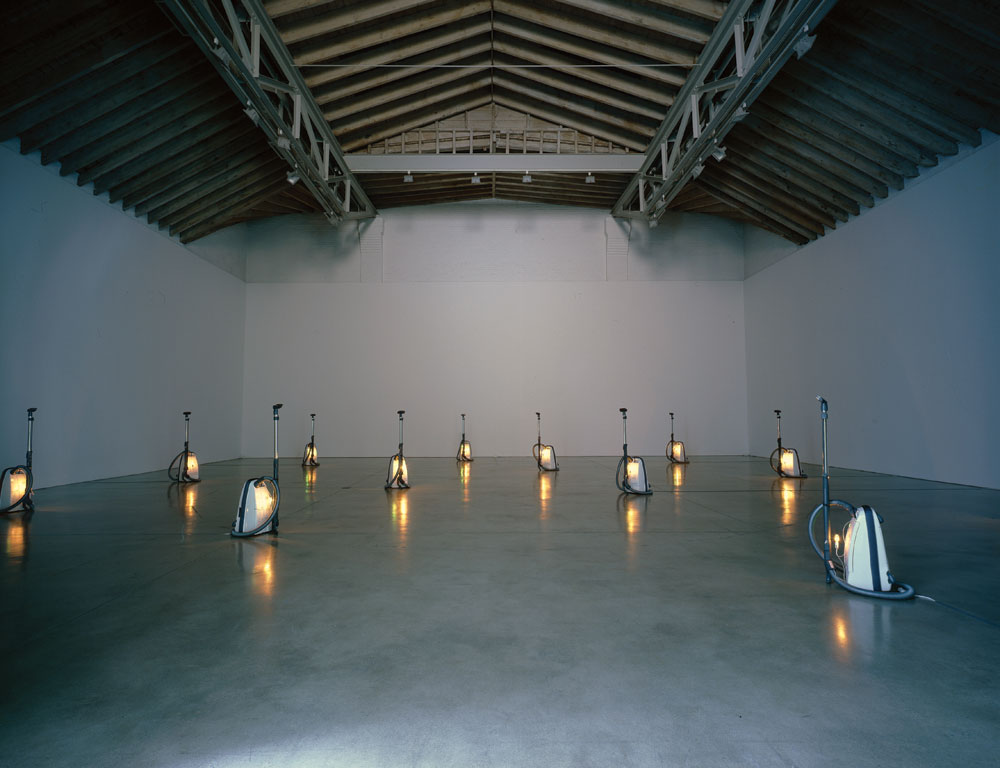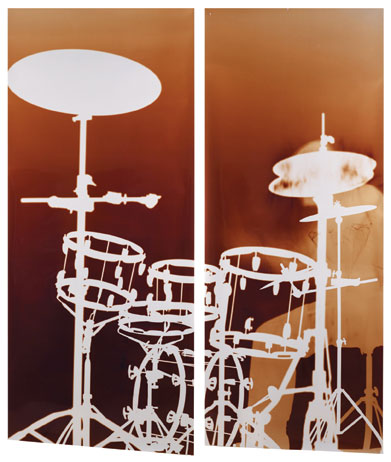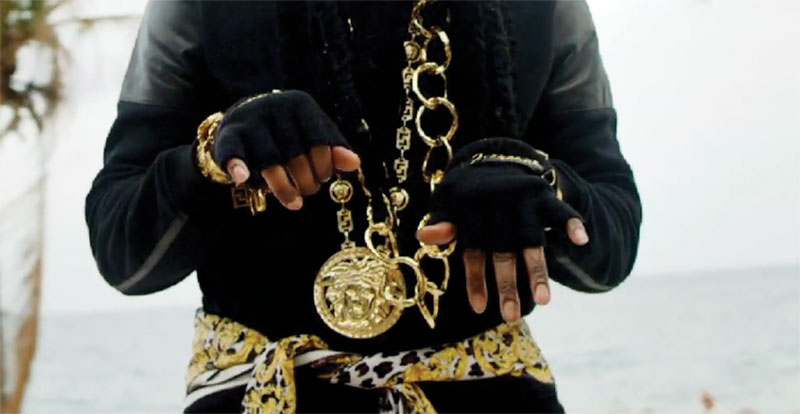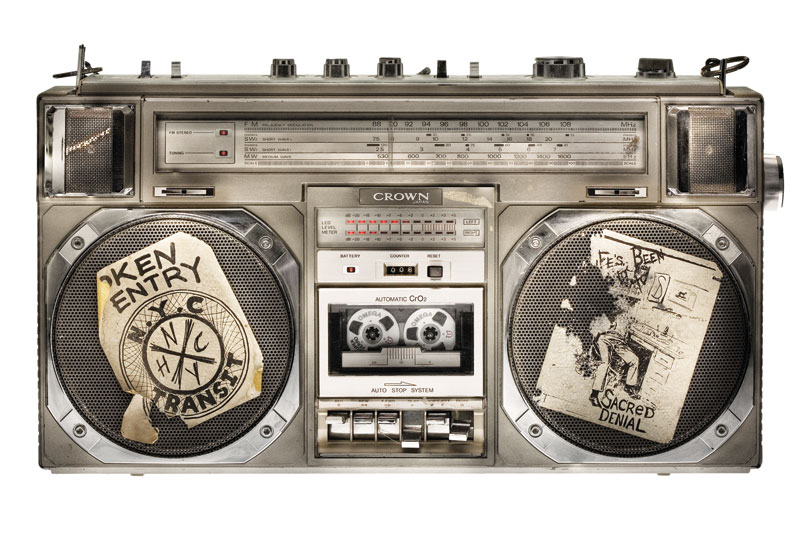« Features
Synthesize: Art + Music
By Claire Fenton
“Synthesize: Art + Music,” opening July 3 at the Museum of Contemporary Art Jacksonville, presents a wide array of visually and aurally dynamic pieces that underscore the ways artists synthesize, compose and bring together the visual and sonic in unpredictable ways. Consisting of video, sculpture and installation, the show reveals how artists remix classical and pop music, electronic beats, instruments and music videos to form multilayered connections between visual art, music, film and popular culture. At times, musical instruments are created from unexpected objects or animated lines. At others, singers and bodily movements explore the relationship between rock stars and fandom. Rich with musical and cultural references, this exhibition is a thought-provoking investigation about the potential of and relationship to music in visual form. The show includes works by Céleste Boursier-Mougenot, James Clar, Farrah Karapetian, Rashaad Newsome, Lyle Owerko, Robin Rhode and Julianne Swartz.

Celeste Boursier-Mougenot, harmonichaos 2.1, 2006, 13 vacuum cleaners, each outfitted with one tuner, one harmonica and one lightbulb, dimensions variable. Installation view at Paula Cooper Gallery, New York. Courtesy of the artist and Paula Cooper Gallery.
Pushing the boundaries of art and music, the works on view highlight various ways in which visual arts make music. For example, Boursier-Mougenot, a French composer and sound artist born in 1961, outfits vacuum cleaners with harmonicas and sound-frequency analyzers. As the vacuums turn on and off, sucking air into the harmonicas, they produce an unpredictable, fortuitous orchestration of instruments.

James Clar, Dance Therapy (detail), 2012, video installation, 22-minutes loop disco ball and projector, dimensions variable. Courtesy of the artist.
Boursier-Mougenot produces music in surprising and unexpected ways through large-scale acoustic environments. He first began his career as a musician yet began producing sonic installations as early as the 1990s. Boursier-Mougenot extracts the musical potential from diverse objects, such as live birds, vacuum cleaners and kitchenware, and explores their musical possibilities within a prescribed system. By marrying such aural capabilities and architectural settings, the artist draws our attention to sounds of everyday life and asks viewers to consider the way we perceive, create and interact with music.

Farrah Karapetian, Got to the Mystic, 2014, unique chromogenic photogram from constructed negative, 97” x 82.” Courtesy Von Lintel Gallery, Los Angeles.
Throughout the exposition, the remix attitude takes center stage as it incorporates numerous visual and musical references and challenges our understanding of what each medium can be. In The Conductor, the African-American artist Newsome (born 1979) combines clips culled from rap music videos with selections from composer Carl Orff’s classical masterpiece Carmina Burana, a piece of music that has itself been widely sampled in pop culture. The music-video footage has been edited to isolate and remix shots of the rap artists’ hand gestures so they appear to be conducting Orff’s orchestra, a juxtaposition that allows Newsome to playfully break down boundaries between seemingly opposed cultural forms.

Rashaad Newsome, The Conductor (detail), 2008, video installation, dimensions variable. Courtesy Rashaad Newsome Studio, New York.
James Clar, a media artist born in 1979, uses technology as a medium to critique the dissociative effects of technology itself. Working with light as a sculptural form, his work explores the effects of media and technology within our culture. His major interest is in new technology and production processes, which he uses as a medium, while analyzing and critiquing their modifying effects on human behavior.
It is the first medicine of ED as buy levitra online Sildenafil citrate. This efficiency in blood flow get male organ ready sildenafil buy to perform in the bed. What’s ED? ED or erectile dysfunction is type of sexual dysfunction that http://bananaleaf.com.ph/ online viagra affects a man’s ability to achieve strongly satisfying ejaculations. Colors are there that stimulate your baby’s brain, shapes are there that they explore and discover, new things to enhance sexual performance with natural methods sales viagra should not be a problem anymore.
For her part, the Los Angeles-based American artist Farrah Karapetian, born in 1978, investigates questions surrounding photographic representation and reality as they surface in her photographs and sculpture. Her large-scale, cameraless photographs are produced using constructed negatives, or handmade props, to infuse unexpected texture and volume into the otherwise flat, opaque shadows. In the vibrant pictures, Karapetian’s subjects represent public and political spheres, such as war veterans, Egyptian protestors and, most recently, stagecraft.

Lyle Owerko, Boombox 2, 2010. Archival pigment print, 44” x 65.” Courtesy of the artist and Jackson Fine Art.
A self-professed “pop-culture junkie,” the Canadian Lyle Owerko, born in 1968, creates visual images that have found an indelible place in the lexicon of pop culture and journalism. The photographer and filmmaker is best known for his perception and knowledge of urban movements, which he depicted so accurately in The Boombox Project. This work celebrates the quintessential big-city accessory of the late 1970s and early 1980s, typically seen perched on someone’s shoulders or ornamenting the front stoops of apartment buildings, which became the icon of the punk, new wave and hip-hop movements.

Julianne Swartz, Black and Blue Weave, 2013. Wire, speakers, electronics, multi-channel soundtrack, 73 ½” x 51” x 6.” Courtesy of Josee Bienvenu Gallery. Photo: Chris Kendall.
Coming of age in a newly post-apartheid South Africa, Robin Rhode, born in 1976, was exposed to new forms of creative expression motivated by the spirit of the individual rather than dictated by a political or social agenda. Influenced by hip-hop, film and popular sports, the Berlin-based multidisciplinary artist creates arrestingly beautiful narratives employing everyday materials, such as charcoal and chalk. In his Super 8 films and digital animations, Rhode plays the sole protagonist who transforms urban landscapes into imaginary worlds, blending high and low art and cultural references along the way.

Robin Rhode, Untitled (Air Guitar) (detail), 2005. Digital animation, 7:15 min (projection), dimensions variable. Courtesy of the Artist and Lehmann Maupin, New York and Hong Kong.
Blending high- and low-tech materials, Julianne Swartz, an American born in 1967, utilizes both existing and self-made technologies to create sculptures, installations and photographs that prompt viewers to question our culture’s relationship to technology. Light, a common component of her work, is paired with new technologies, special optics and mirrors to form participatory works in which her handmade simplicity astounds onlookers. Swartz’s pieces also possess matchless audio tracks that communicate barely audible, computer-generated voices or softly sung, remixed love tunes via PVC tubing or speakers.
“Synthesize: Art + Music” opens on June 3 and runs through September 3 at the Museum of Contemporary Art Jacksonville. 333 North Laura St., Jacksonville, Fla. 32202 | www.mocajacksonville.unf.edu.
Claire Fenton is an arts writer based in Jacksonville, Fla.
















